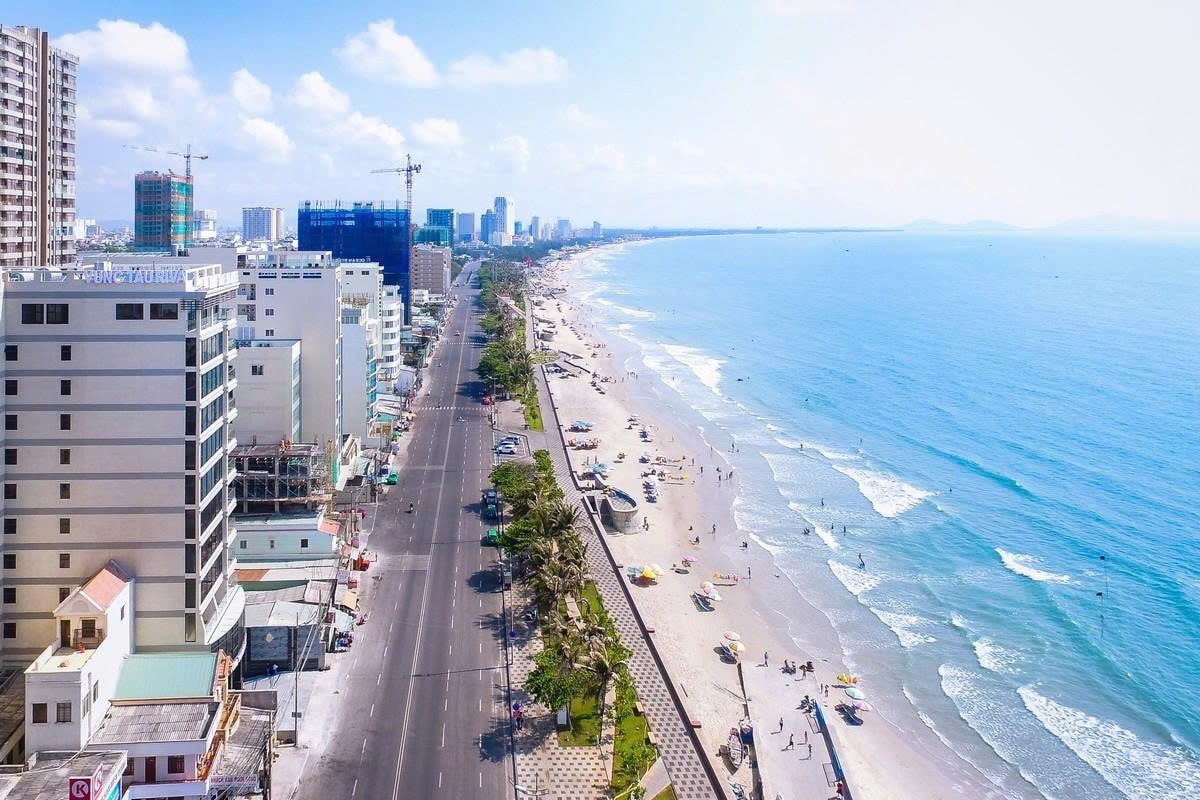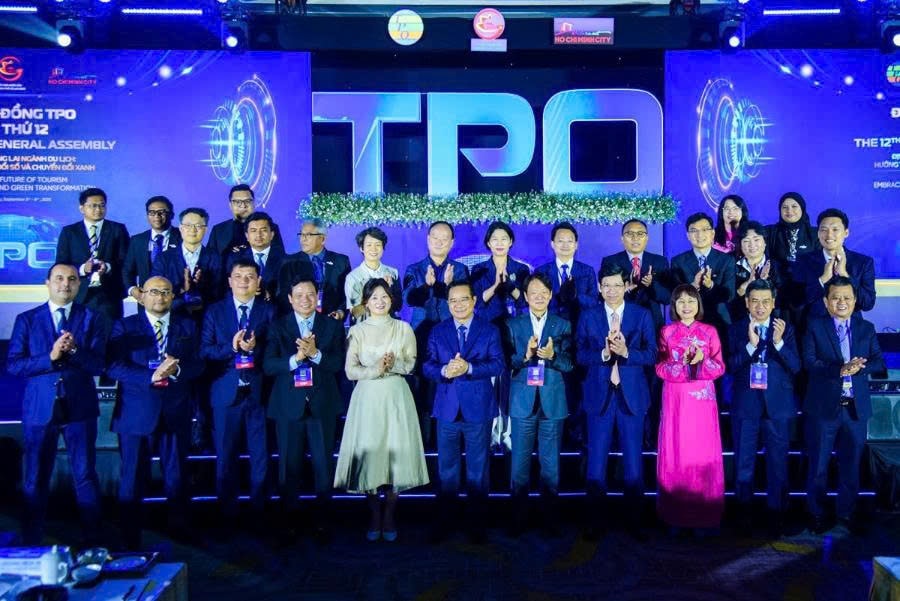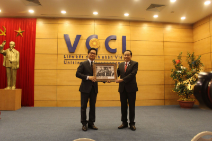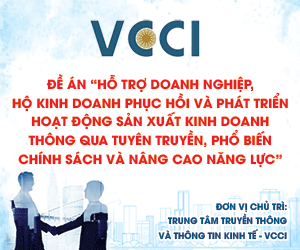Supporting investment promotion and tourism development in HCM City
It is projected that Ho Chi Minh City's total tourism revenue for the first nine months of 2025 will be close to 190,000 billion VND. It is projected that 5,883,285 foreign visitors will arrive in Ho Chi Minh City, accounting for 69.2% of the 2025 plan.

Back Beach is a Vung Tau beach with a 10km long coastline suitable for tourists to swim and participate in underwater activities.
The expected number of domestic visitors to Ho Chi Minh City is 29,179,468; this represents 64.8% of the 2025 plan, as opposed to the 2025 aim of 58.4%. Compared to the 2025 objective of 63.7%, the expected total tourist earnings for the first nine months of 2025 would be 184,629 billion VND, or 71% of the 2025 plan.
During the post-merger period (July 1–present), Ho Chi Minh City (new) was created by combining three localities: Binh Duong province, Ba Ria in Vung Tau province, and Ho Chi Minh City.
The tourism sector is one of the key growth drivers that is helping to steer the city toward becoming a "international megacity" as it strives for double-digit economic growth. In the new context, Ho Chi Minh City is confronted with numerous opportunities to emerge and compete with cities in the region and the world.
In Vung Tau City, the Department of tourist has organized in collaboration with the City People's Council's Economic-Budget Committee to review the present state of affairs, possibilities, and difficulties, as well as to provide policies and solutions to promote the growth of the tourist industry. Finish the three policy and advisory tasks; deploy the strategic tasks concurrently. It concludes that Ho Chi Minh City has advantages in the following areas in the new era: infrastructure for traffic, human resources, tourism products, and tourism service facilities.
Ho Chi Minh City's tourist product development has been carried out in a synchronized, varied, and fruitful manner, which has enhanced the city's tourism product ecosystem. In order to perform surveys and plan and build many routes, destinations, and standard tourism goods, the Department of Tourism has concentrated on collaborating with other departments, branches, communities, and enterprises.
Ho Chi Minh City has been conducting surveys, investigations, and evaluations of tourism resources in the post-merger period in order to reposition products and create new product development orientations. Create unique tourist offerings for every community after evident management decentralization. Concentrate on growing night tourism in relation to testing public-private cooperation mechanisms in the cultural and athletic domains, such as art exhibits and museum visits at night. In order to encourage companies to invest and efficiently utilize seaports, waterway ports, piers, etc. to develop waterway tourism, legislation pertaining to the establishment and operation of inland waterway ports, passenger ports, etc., should be reviewed and amended.
The evaluation states that the city's tourist sector grew steadily and recovered well in the first nine months of 2025. The city continued to be a key hub for tourism in the nation, contributing significantly to the surge in both domestic and foreign tourists, particularly for weekend, river, and short-term travel. The number of rooms occupied rose.
The promotion and advertising of the City's tourism image has been stepped up, and the City's tourism communication on many digital platforms has achieved positive results. Many events have been successfully organized, especially the International Tourism Fair ITE HCMC 2025 and the 12th General Assembly of the Tourism Promotion Organization for Global Cities (TPO 2025), which draws a lot of foreign tourists, partners, companies, and media. These occasions have strengthened Ho Chi Minh City's standing as a major tourist destination in the nation and improved its standing on the global tourism map.
In order to boost destination brand identification, 2025 tourist stimulant programs with several incentive packages were introduced, utilizing social media and internet channels. Clearly defined goals for product and market development Keep funding strategic product lines, such as river tourism, healthcare, MICE, heritage, culture, and history, night tourism, green tourism, etc.
Positive benefits are produced when international partnerships, interregional collaboration, and communication are adopted together. focusing on developing and prospective global markets, such those in the Middle East, Northern Europe, and India, by encouraging collaboration with consulates general, airlines, and foreign businesses.
Innovation in digital transformation and state administration, including advising and successfully carrying out management tasks in the context of combining administrative units and changing the two-level government paradigm. enhancing administrative reform, digitization, and the creation of a database for the travel and tourist sector while assisting companies with timely registration and information updates.
In the final months of 2025, Ho Chi Minh City aims to attract between 8,500,000 and 10,000,000 foreign visitors (the initial goal was 8.5 million); domestic tourists aim to attract between 45,000,000 and 50,000,000 visitors (the previous goal was 45 million); and total tourism revenue reaches approximately 290,000 billion VND (the previous goal was 260,000 billion VND) in order to support double-digit economic growth in the region.
The Global Cities Tourism Promotion Organization's General Assembly
With this event, Ho Chi Minh City reaffirms its position as a hub for fostering regional tourist growth and connecting people in order to create a contemporary and sustainable tourism sector.
The Tourism Promotion Organization for Global Cities (TPO) held its 12th General Assembly in Ho Chi Minh City on September 3. As part of the Ho Chi Minh City International Travel Expo (ITE HCMC), Ho Chi Minh City was privileged to host the TPO General Assembly for the first time in Vietnam.
It is a "killing two birds with one stone" tactic to host the TPO General Assembly, which will boost international recognition and generate momentum for innovation, tourism, and economic growth.
The conference, which has its topic "Shaping the future of tourism: Towards digital transformation and green transformation," provides a significant platform for participants to talk about two themes that are unavoidable in contemporary travel: sustainable development and digital transformation.
As the only city in Vietnam to serve as a member of the TPO Executive Board and one of the founding cities, Ho Chi Minh City has been proud to actively participate in the organization's operations for the past 20 years, consistently encouraging relationships and collaboration in the growth of tourism among its members, stressed Nguyen Van Duoc, chairman of the Ho Chi Minh City People's Committee. while reaffirming its pivotal role in the growth of tourism in the area."
Hosting the TPO General Assembly this time is a significant milestone, according to Nguyen Van Duoc, Chairman of the Ho Chi Minh City People's Committee. It amply demonstrates Ho Chi Minh City's responsibility and commitment to promoting regional tourism to develop synchronously, creatively, and sustainably.

Leaders, experts and tourism organizations from many countries and territories at the 12th TPO General Assembly. Photo: Ho Chi Minh City Electronic Information Portal
Given the significant issues facing the tourism sector, including climate change, the need to customize the visitor experience, and the rapid advancement of artificial intelligence and technology, the TPO 2025 General Assembly is a crucial agenda item.
In addition to being trends, digital transformation and green transformation are essential components of the tourist industry's sustainable growth. While green transformation lessens its impact on the environment and preserves resources and cultural identity, digital transformation aids in better management, enhances the visitor experience, and opens up new markets. According to the United Nations' 17 sustainable development objectives, these two strategic pillars influence the industry's identity, structure, and course of growth.
Furthermore, seminars, high-level forums, and bilateral conferences will concentrate on sustainable tourism development and digital technology application solutions, assisting Ho Chi Minh City in updating trends and developing suitable tourist plans.
Business support consulting
With an emphasis on creating "attractive-smart-sustainable" tourism and encouraging investment in a variety of goods, Ho Chi Minh City provides preferential loans to tourist enterprises for investments in technology, equipment, and building. With a large number of both local and foreign tourists, the city's tourism sector has grown significantly.
For the support for investment promotion, the City budget offers interest rate support to tourism firms for loans for building (up to 70% support) and equipment (up to 85% support) investments.
To guarantee its implementation in the city's new environment, the Ho Chi Minh City Department of Tourism is evaluating and suggesting extending the policy's beneficiaries.
Utilizing the benefits of several centers and goods, the city is focused on growth in accordance with the "attractive - smart - sustainable" concept.
The main focus of Ho Chi Minh City is the development of many forms of tourism, ranging from high-tech agriculture and ecology to conventions, culture, and suburban resorts.
Ho Chi Minh City has aggressively promoted commerce, investment, and tourism through a number of domestic and international fairs, conferences, and exhibits. In keeping with worldwide trends, issues including digital transformation, eco-friendly travel, and the green economy are being given priority. Consequently, Ho Chi Minh City had double-digit growth in the latter months of 2025.








